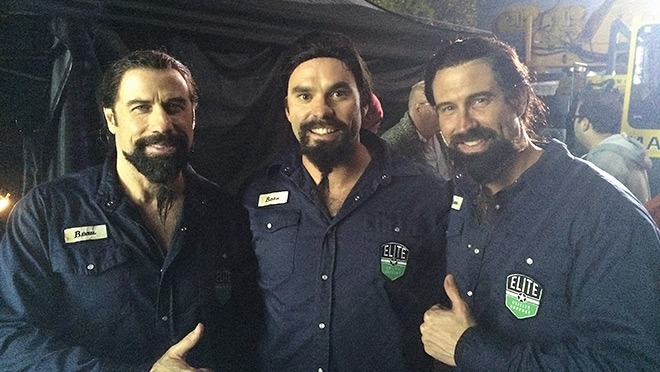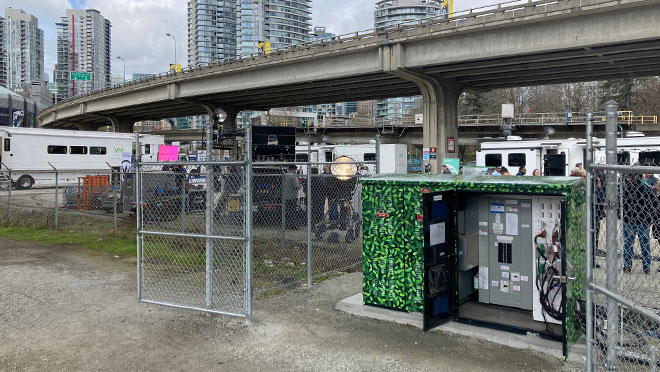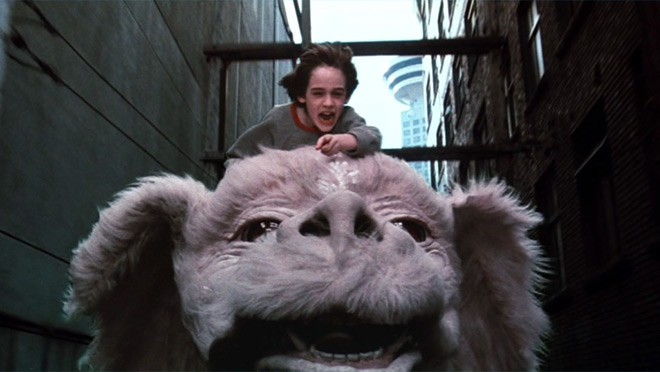Lights! Camera! Green energy! Electrifying B.C. film and TV

BC Hydro works to take film and TV production in B.C. off fossil fuels
When Hollywood goes north, it often lands in B.C. And in keeping with Creative B.C.'s Real Green sustainability program, we're making moves to help the film and TV industry shoot greener when it shoots in the province.
"Diesel is a reliable energy source for movie production and the film industry, but its also greenhouse gas emitting, noisy and smelly for anyone living or working in the area," says BC Hydro's Meaghan Fahey, who as a key account manager works with our properties team to support the film and TV industry. "What we've been working on is a plan for at-site power kiosks in locations where there is a lot of filming or other activities, like events, street fairs or food trucks."
London-based film production designer and sustainability activist Blair Barnette estimates that the average diesel-powered film set uses 20 gallons of diesel every 12 hours. "Diesel generators also cause noise pollution," Barnette wrote in a LinkedIn post in February. "A single diesel generator emits a noise level of 73 decibels. It's pretty much like standing next to a blender all day."
Creative BC, which oversees B.C.'s film, TV, and other creative industries, has launched an online CO2 calculator for film companies to use as part of its Reel Green sustainability program. According to Vancouver city councillor Adriane Carr, who put forward the clean energy kiosk motion in 2019, it's estimated the initiative will reduce film set-related carbon emissions in Vancouver by about 6,500 metric tonnes annually.
"I just had one motive: get Vancouver to support us moving off diesel generators, which are bad for the environment, and bad for people's health and well-being working on sets, and move to clean energy power drops," said Green party councillor Carr.
For often-used locations, the new clean energy kiosks initiative – a co-operative effort between BC Hydro and cities/municipalities – will supply power to villages of trailers, machines, and lights that often accompany filmmaking. Each kiosk is owned and operated by a municipality or city, and is another way B.C. is using the power of water – our primarily hydroelectric power is 98% clean – to reduce carbon emissions by electrifying homes, businesses and operations in B.C.
"A kiosk is essentially a giant plug on a street corner," says BC Hydro's Fahey. "I would almost liken it to an EV charging station. It provides a higher output of power than a normal plug, and the panel is meant to mimic a diesel generator panel. It's designed to accommodate the larger-sized plugs used on film sets."

Top 20 filming sites identified for kiosk program
Funding for low-carbon initiatives that use clean energy to move away from the use of fossil fuels helped our key accounts team develop a proposal for kiosks for the top 20 filming sites in the Lower Mainland.
"There are a lot of benefits to these kiosks, including a net electrical growth for us, not to mention that it saves GHG emissions, smells nice and has no sound," says Fahey. "It limits greenhouse gas production in the community and for those working on the set, and it also looks nicer."
The City of Maple Ridge is the first to apply for this funding for the clean energy kiosks. Maple Ridge is one of the many locations that Hallmark holiday specials and other productions are filmed, due to its village-like areas and scenic location.
There's also a kiosk hard at work in downtown Vancouver that's used frequently to power stage trailers and service providers during filming. If you've taken the Expo Skytrain line into or out of Vancouver, you may have seen this area full of trailers or machinery underneath the track near Rogers Arena at Carrall and Pacific streets. It took nearly two years to move through right-of-way issues, permits and other details, but the kiosk is now up and running for use by film and other industries in the area.
Vancouver Mayor Ken Sim said that in its drive to be a world leader in both sustainability and in film and TV production, it makes sense that the city would make it possible to use clean energy on film sets. The city is also out to eliminate generators on food trucks, to make electric vehicles more available for special events, and to increase charging options for e-bikes, scooters and EVs.
"B.C.'s $4 billion film industry is one of our greatest economic assets, and productions right across our city will be cleaner, quieter, and more sustainable with the clean energy kiosk network," said Sim.
Part of the plan is to build a kiosk outside BC Hydro's head office in downtown Vancouver within the next year, as film crews regularly set up shop on Homer Street.
"I'm hoping that these kiosks will help electrify the film industry as much as possible," says Fahey. "There are around five new film studio spaces being built in the Lower Mainland and they're looking to apply for CleanBC funding to electrify their operations. Overall, we're hoping to make the film industry in B.C. one of the greenest in North America, and electrification is one of the best solutions."
Film and BC Hydro got things going in the 1980s
Hollywood-based filming in B.C. in the 1970s and 1980 was largely based in scenic or rural areas, such as the Rockies. But it took a turn to urban environments, as the lower Canadian dollar convinced filmmakers to use Vancouver in particular as a stand-in for U.S. cities.
And our electricity system, including reservoirs, dams, and powerhouses, helped draw film crews to B.C.
Two films were shot at the then BC Hydro-owned Dominion Bridge property in central Burnaby: Mother Lode (1981) and Runaway (1983), which also featured a novel car chase scene over the Burrard Street Bridge. And over the past 20 years, production companies have filmed scenes at BC Hydro locations throughout the Lower Mainland for television shows and feature films, such as The X- Files, Dark Angel, Smallville, Sliders, and Alien vs. Predator.
Buntzen and Alouette Lake, the former Grandview Substation and the former Lower Mainland Control Centre properties are now on the radar of production companies, especially for action filming. Grandview filming projects in 2013 included: Supernatural, Arrow, The 100 and Almost Human.

Spot BC Hydro in these shows and movies
Wondering where you might have seen BC Hydro on film? Next time you're watching one of these, keep a sharp eye out for BC Hydro locations.
The Powerhouse at Stave Falls turbine room: X Men 2: X Men United; The X-Files
Ruskin Dam: Smallville episodes 621 "Prototype", 622 "Phantom", and 701 "Bizarro"; Dark Angel episode 119 "Meow"; MacGyver, Season 5, episode 8 "Black Rhino".
Annacis Island Substation: Fringe episode 404 "Subject 9"
H-frame power poles in the alleys of downtown Vancouver: The NeverEnding Story, 5.5 minutes in, Trounce Alley in Gastown
Buntzen Lake: Cedar Cove
Burrard Thermal Generation Station: Alien vs. Predator